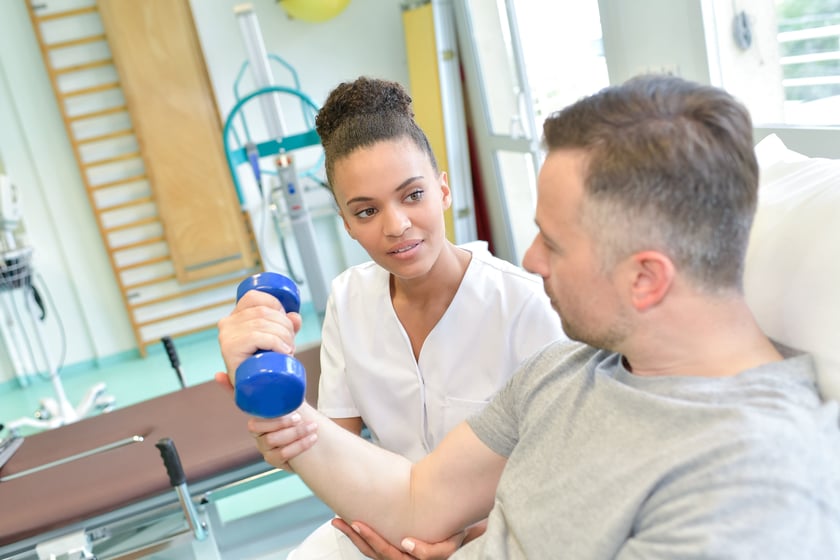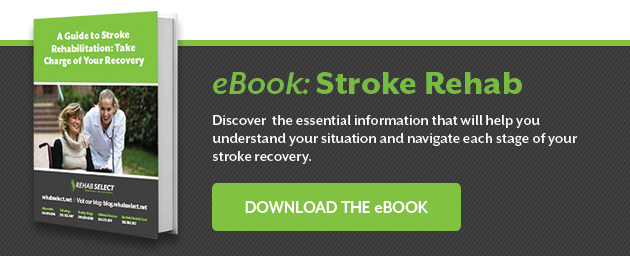
The stroke recovery timeline is unpredictable. Some patients may recover completely within weeks of a stroke; others may take months or even years to fully recover; and still others may experience moderate to severe side effects on a permanent basis.
Recent research suggests that around 1 out of every 3 stroke sufferers have a disability that affects their lives on an on-going basis. In this article, we’ll look at the most common long-term side effects of stroke, address the main factors that can affect stroke recovery time, and review the stages of stroke recovery — including rehab for stroke patients.
Long Term Effects of Stroke
Stroke side effects can be grouped into physical, cognitive ,and emotional symptoms. Some side effects only impact patients in the immediate aftermath of the stroke and are easy to treat. Others can be more long-lasting. The most common long-term effects of stroke include:
Aphasia
Aphasia is the medical term used to describe difficulties with language use. It is the most common long-term effect of strokes. Patients may struggle to find the right words, or have difficulty forming words or making themselves understood. They may also have problems understanding what people are saying, or have difficulty reading.
Depression
Depression after stroke is a very common long-term effect. Patients suffering from post-stroke depression will experience symptoms including alterations in sleep patterns and appetite, low moods, irritability and feelings of hopelessness. A diagnosis of depression will be given if these symptoms linger for more than two weeks.
Muscle weakness and/or paralysis
Many people experience weakness or partial paralysis after a stroke. This might present itself as a difficulty gripping or holding things, problems with muscle control and movement, spasticity, an inability to move whole muscle groups, or bladder or bowel incontinence.
Memory impairment
Patients frequently experience long-term issues with their memories after a stroke. This might take the form of a difficulty learning new skills, problems with working memory, orientative memory (knowing the day and time), or remembering names or faces.
How Long Does It Take to Recover from a Stroke?
It is very difficult to estimate how long a patient will take to recover from a stroke, which symptoms they will experience, and if those symptoms will resolve themselves over time or be permanently disabling. A number of factors affect how long recovery will take:
Stroke Type
There are several different types of strokes, and they will have varying impacts on the patient’s stroke recovery timeline. Stroke types include:
Transient ischemic attack (TIA)
Sometimes called a “warning stroke,” TIAs are not full-blown strokes and are therefore less likely to cause long-term severe side effects. During a TIA, the patient experiences “stroke-like” symptoms for a period of hours.
Ischemic Stroke
Ischemic strokes are the most common type - up to 87% of strokes are ischemic. In this type of stroke, a blood vessel to the brain is obstructed by a clot.
Hemorrhagic Stroke
This type of stroke involves a bleed in the brain, usually when a weakened blood vessel ruptures. Blood collecting in the brain tissue causes it to weaken and die.
Stroke Location
The type of side effects experienced by a patient will vary depending on whether the stroke happens in the left or right hemisphere of the brain, or in the brain stem.
Left brain stroke
If the stroke affects the left side of the brain, the patient will be more likely to experience paralysis on the right side of the body, aphasia, memory issues, and hesitant, slow movements and behavior.
Right brain stroke
Patients with a stroke on the right side of the brain are more likely to experience left-body paralysis or weakness, vision problems, memory loss, and quicker movements and behavior.
Brain stem stroke
Brain stem strokes are difficult to diagnose. Usually, brain stem stroke patients experience severe dizziness and loss of balance, double vision, slurred speech, and loss of consciousness. Severe brain stem strokes can cause locked-in syndrome, in which the patient can only move their eyes. In mild and moderate cases, double vision and vertigo can resolve themselves after several weeks. Language abilities are not usually affected by brain stem stroke.
The function of the brain area affected by the stroke will also have an impact on symptoms and recovery rates. For example, a stroke toward the back of the brain will likely have an impact on vision.
Stroke Severity
Of course, the most significant factor for a stroke recovery timeline is how serious the stroke was. The stroke may only have caused blood flow loss to a small area of the brain, in which case recovery will be faster and easier. If the stroke affected a larger area, recovery will obviously take longer.
If the patient received prompt treatment immediately after the stroke, the damage will often be less severe than in a patient whose stroke passed unnoticed for hours. According to the National Stroke Association, 10% of stroke patients will recover completely; 25% will suffer mild on-going symptoms; 40% will be moderately impaired, and 10% will require long-term care.
Rehab for Stroke Patients
Rehab for stroke patients will be different for every individual who experiences this acute health episode. The stroke recovery timeline is intended only as a rough guide for what to expect.
Stage 1: Initial Recovery
The process of stroke recovery begins as soon as the stroke victim has been treated for any critical symptoms, while the patient is in hospital. Doctors will take preventive measures to avoid any further strokes. Rehab for stroke patients will often begin at this stage also; individuals are encouraged to sit up, move around, and if possible, stand and walk around.
Stage 2: First 2 weeks
Patients who have experienced a minor health episode will usually be discharged from the hospital within a week and receive ongoing treatment for mild stroke. Survivors of major strokes may take longer to leave intensive care. Once discharged, patients with severe side effects will likely be transferred to a long-term acute care facility; those with less serious issues will either be referred to an inpatient or outpatient rehab center. Most patients will experience a 50% recovery within the first two weeks.
Stage 3: Month 3
All patients are recommended to undergo intensive rehabilitative therapy during the first two to three months of recovery. The Stroke Association explains:
“For the first three months after a stroke, the brain is much like a new brain. It’s ready to learn, ready to make new connections. This ability for our brains to adjust is known as neuroplasticity and it plays a vital role in recovery. It takes about three months after the stroke for neuroplasticity to return to a more normal state. After that, a survivor can still work on regaining function and practice for improvement, but those improvements may come at a slower pace.”
Stage 4: Beyond Month 3
Once patients have completed a course of intensive rehab, they will be advised to continue rehabilitation at home. The rehab team will provide guidance on appropriate exercises and lifestyle choices, designed to improve quality of life, minimize remaining post-stroke symptoms, and reduce the risk of another stroke. While the majority of recovery takes place in the first weeks and months after a stroke, the Mayo Clinic confirms that “performance can improve even 12 to 18 months [afterward].”
Discover Stroke Rehab Services in Alabama
Recovering from a stroke can be a challenging and frustrating experience. Rehab for stroke patients is tough, both mentally and physically. However, it is worth sticking with it and, with dedication and perseverance, many patients find they can make great improvements. If you would like to know more about how the team at Rehab Select can help with stroke recovery, please visit our website or click here to contact us.





